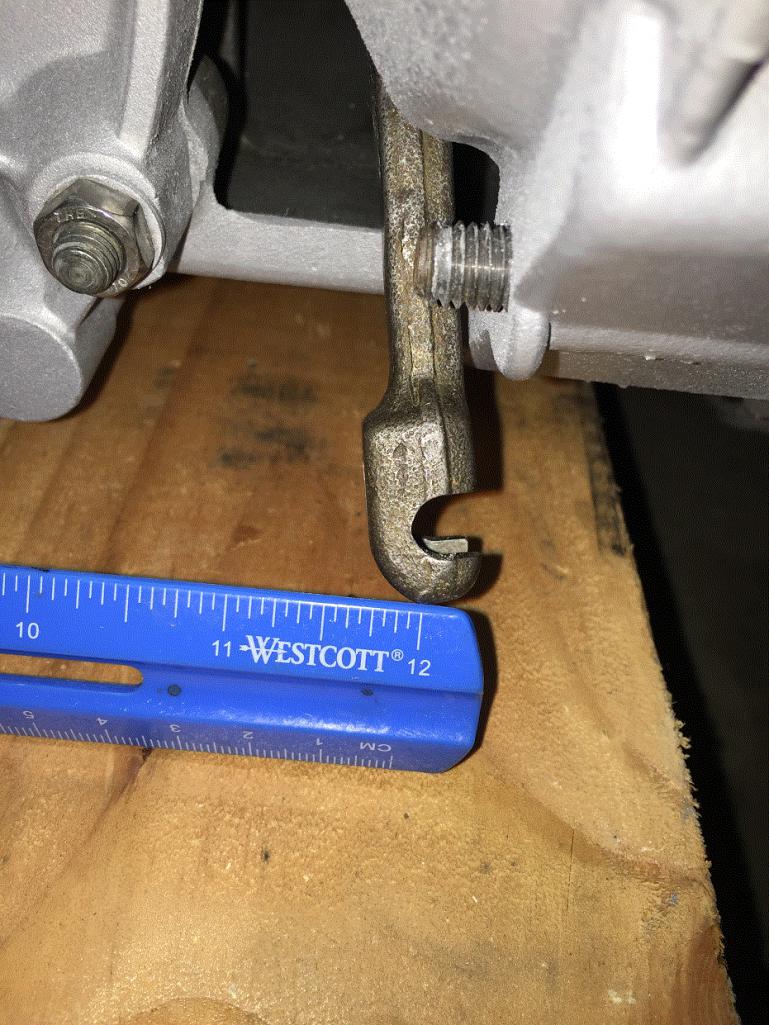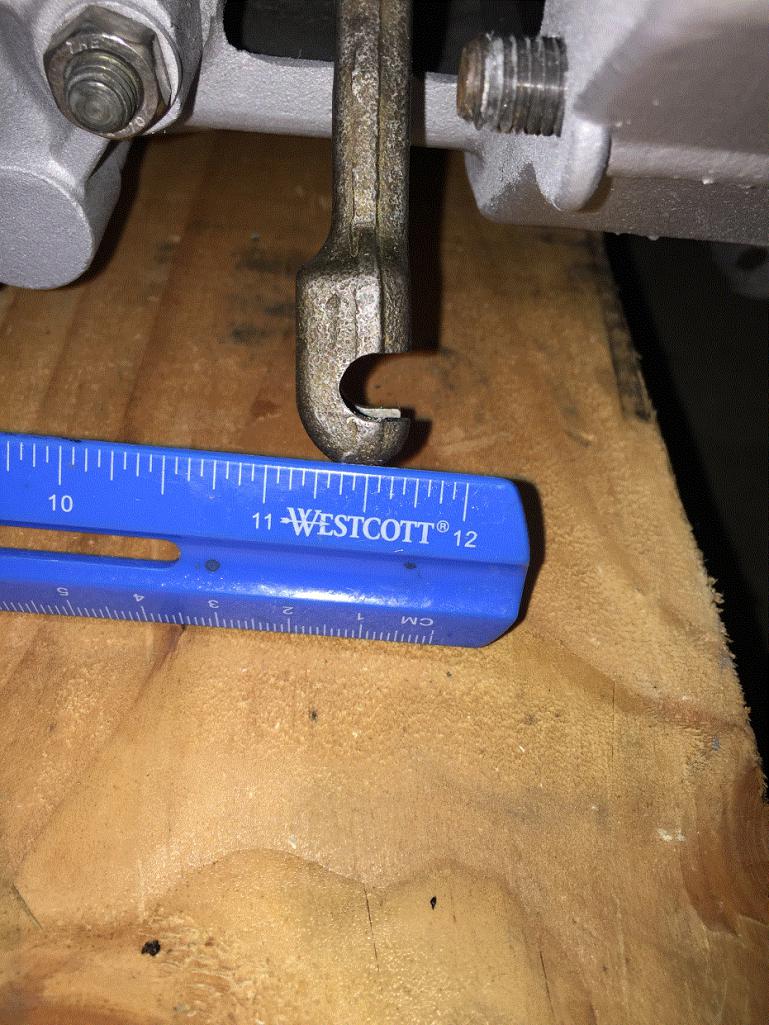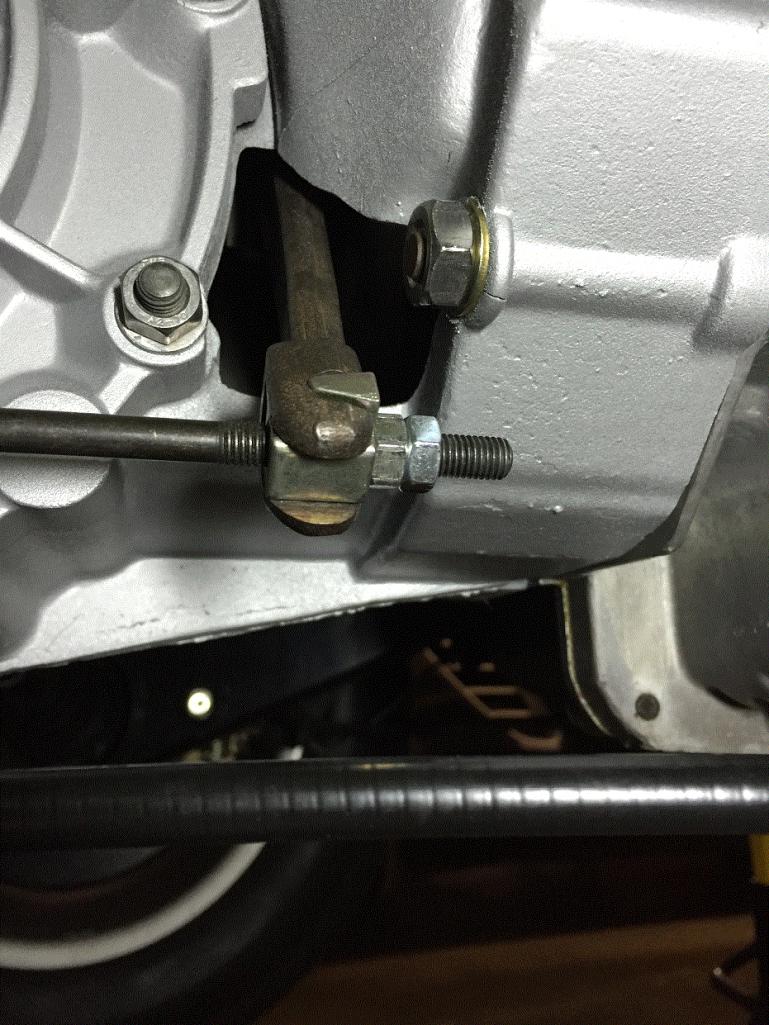Printable Version of Topic
Click here to view this topic in its original format
914World.com _ 914World Garage _ Clutch Fork Throw Measurement
Posted by: Nozzle May 26 2016, 04:03 PM
Hey folks. So after just about two years I'm getting ready to finally reinstall the rebuilt engine and refreshed trans-axle. Before getting the drive-train back up in the car though I read in the Pelican clutch change tech article to check the clutch fork for adequate throw of 0.5 inch. Problem is I'm not sure where to measure from on the fork so I took these picks for a 914World QA check before going any further.

Posted by: r_towle May 26 2016, 05:11 PM
Not sure what the question is, but your clutch fork arm is too dirty for that transmission.
Posted by: tomrev May 26 2016, 05:55 PM
With the fork pulled towards the rear of the car, and in contact with the clutch fingers, there needs to be at least a 1/2 in. of room , for the fork to keep moving rearwards before it hits the diff cover part of the box. I want more than that myself, but that is what PP is referring to. I usually shim the fork ball out with a second washer, and have even heated, and bent the fork to give additional room to operate the clutch. Make sense?
Posted by: somd914 May 26 2016, 06:27 PM
So I know that in the second photo Nozzle's lunch fork arm is hitting the point of engagement. He is unsure with the rebuild whether the flywheel was replaced or machined, thus if machined an additional washer is likely needed on the pivot arm.
Thus Nozzle is trying to determine if a shim is necessary...
Posted by: r_towle May 26 2016, 06:33 PM
The measurement is from the second position to fully released, so all the way to the tranny side of that slot.
The key is this.....
Does the pressure plate fully release the clutch before the release fork hits the transmission housing.
The best test is still to push that fork (put a pipe over the end) all the way to 1/2 inch away from the housing and see if the axle flanges move while the tranny is in gear.
With a limited slip diff, both axle flanges will spin the same direction.
With a stock diff, hold one of the flanges in place and use the other flange for your tests...
How's that for confusing?
Posted by: Nozzle May 26 2016, 07:57 PM
The measurement is from the second position to fully released, so all the way to the tranny side of that slot.
The key is this.....
Does the pressure plate fully release the clutch before the release fork hits the transmission housing.
The best test is still to push that fork (put a pipe over the end) all the way to 1/2 inch away from the housing and see if the axle flanges move while the tranny is in gear.
With a limited slip diff, both axle flanges will spin the same direction.
With a stock diff, hold one of the flanges in place and use the other flange for your tests...
How's that for confusing?
I think the light bulb is starting to come on. I have a stock diff so I'll give that test a try.
Posted by: r_towle May 26 2016, 07:59 PM
Get a piece of angle iron.
Drill two holes in it that let you bolt it to one of the flanges.
Bolt it towards the end of the angle iron.
Now, when,you turn it the angle iron will hit the floor and stop the flange from turning,any further......now you can test.
Posted by: JamesM May 26 2016, 08:26 PM
Hey folks. So after just about two years I'm getting ready to finally reinstall the rebuilt engine and refreshed trans-axle. Before getting the drive-train back up in the car though I read in the Pelican clutch change tech article to check the clutch fork for adequate throw of 0.5 inch. Problem is I'm not sure where to measure from on the fork so I took these picks for a 914World QA check before going any further.


I generally shim my clutch pivot point to bring the arm as close to the rear as possible when installed, basically if I can slide my pinky (i have small fingers) in between the arm and the tranny then its not shimmed enough. I find this gives the best pedal feel and puts the tip over point in the upper 1/3 of pedal travel.
The 2nd picture you posted, in my experience is way to large a gap. Aim for the first picture.
Posted by: porschetub May 27 2016, 08:53 PM
I didn't measure mine but yours appears ok,if you know the flywheel is machined investigate further towards shiming the ball pivot.
My clutch parts were all new used with a stock unmachined flywheel.
Posted by: Nozzle Jun 3 2016, 01:33 PM
OP Update: Based on the suggestions above I planned to add a shim or two to be on the safe side but couldn't get a socket with a small enough OD to get a bite on the pivot ball. So I left it in the stock configuration, crossed my fingers and went ahead with the install of the drivetrain. I followed the above method of putting the transaxle in gear and used the ability to rotate the axles independently to gauge clutch engagement/disengagement as I adjusted the clutch. Then using Dr. Evil's suggested 1/4-1/3 pedal throw sweet-spot I wound up with an adjustment that looks like the photo below. Does that look right or does the pivot need shims?
Posted by: r_towle Jun 3 2016, 09:34 PM
Looks adjusted properly
Posted by: Nozzle Jun 4 2016, 08:48 AM
Looks adjusted properly
Many thanks Rich, just what I was hoping to hear.
Powered by Invision Power Board (http://www.invisionboard.com)
© Invision Power Services (http://www.invisionpower.com)
